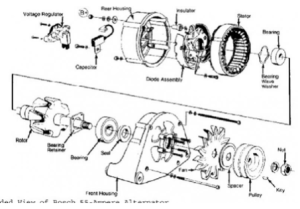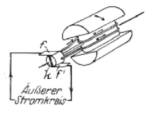Success! I used a big Model No. 1 Dake arbor press. I wouldn’t recommend using anything else to press the new bearings and bushings in. You’ll need an extra set of hands with the press to hold the semi-trailing arm in place while you press. (FYI: a trailing arm is perpendicular to the drive shaft. A semi-trailing arm is at an angle from the drive shaft. The more you know!) Here’s my DIY:
0. Chock front tires, jack up rear end of car, install jack stands unscrew the four lug bolts and remove the tire you’re working on.
1. I unscrewed the 5mm hex nut with an allen wrench and then removed the hub. I sprayed everything down with brake cleaner to minimize the toxic dust, letting the runoff drain onto a drain pan.

2. I then unfastened the CV Joint bolts from the trailing arm splined axle using an electric impact wrench and rolled the CV joint out of the way, propping it up and out of the way.
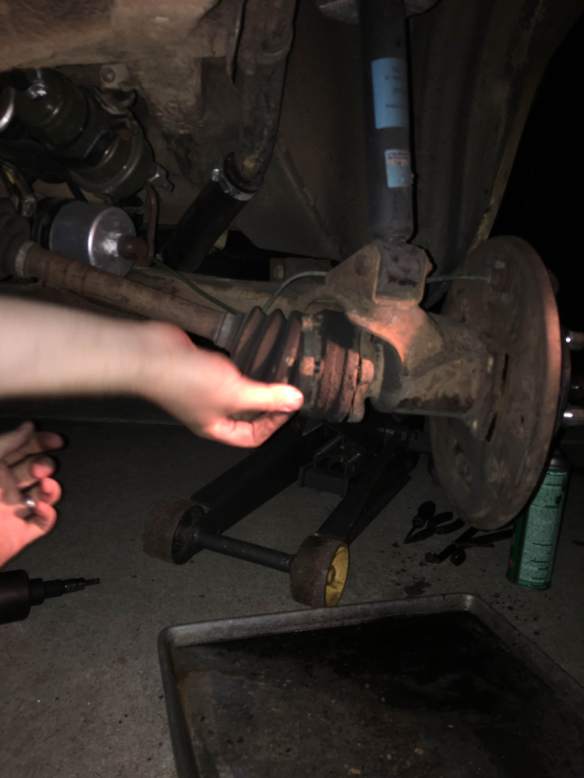
3. I then removed the cotter pin from and put blaster oil on the castellated nut that holds the wheel plate to the splined axle. I used an air impact wrench with a 36mm socket to then remove the castellated nut. It came off easily with the impact.
4. I firmly but gently tapped the edges of the wheel plate with the flat edge of a ball peen hammer and was able to work the wheel plate off the splined axle. I took a sledge hammer and precisely whacked the splined axle and drove it out the back of the trailing arm. The dust cap came out with the splined axle in pristine condition. I didn’t bother trying to replace it. It looked fine and stayed connected to the splined axle. So considering the lead time on getting those from Germany, if it ain’t broke…
5. I unclipped the bottom spring on the drum brakes and then unhooked the parking brake line and fed it out through the back of the brake shield. I unhooked the parking brake line from the little hole where it attaches to the trailing arm. Then I pulled the drum brakes apart being careful not to tear the two rubber boots at the top and removed the drum brakes.
6. I unscrewed the brake line from where it attaches on top of the trailing arm and let it drip into a drain pan. My rear brake lines are not OEM I think. The bolts that attached were a 12mm on the rubber side and a 7/16 on the metal line side. I then unscrewed the four bolts of the brake shield, removed it and set it aside.
7. After that I removed the three bolts that attach the trailing arm (two 19mm to the front where it attaches to the chassis and one 17mm at the rear where it attaches to the rear shock. I pulled the semi-trailing arm out and inspected it. Then I cleaned it off with some simple green.
8. My outer wheel bearing had disintegrated. The cage had crumbled into pieces and the bearings were rolling around loosely inside the races. The inner race of the outer bearing just came out by hand and spilled ball bearings all over the ground. I removed the cylindrical spacer that sleeves around the splined axle between the bearings, wiped the old, brown grease off and set it aside.
9. The bearings butt up to a little shoulder on the inside of each side of the trailing arm. The races of the bearings sit up higher than the shoulder so I took a flat-ended metal punch and tapped the old inner bearing out. It came out pretty easily. On the outer bearing, all that was left on mine was the outer race but the outer bearing has a spacer between it and the shoulder inside the trailing arm that sticks up slightly higher than the shoulder but not as high as the race so I didn’t want to mar it up with the punch. Instead I used an appropriated-sized bearing press tool to drive that outer race out of there. The spacer came out with it intact and undamaged. I wiped all the old grease out of the trailing arm.
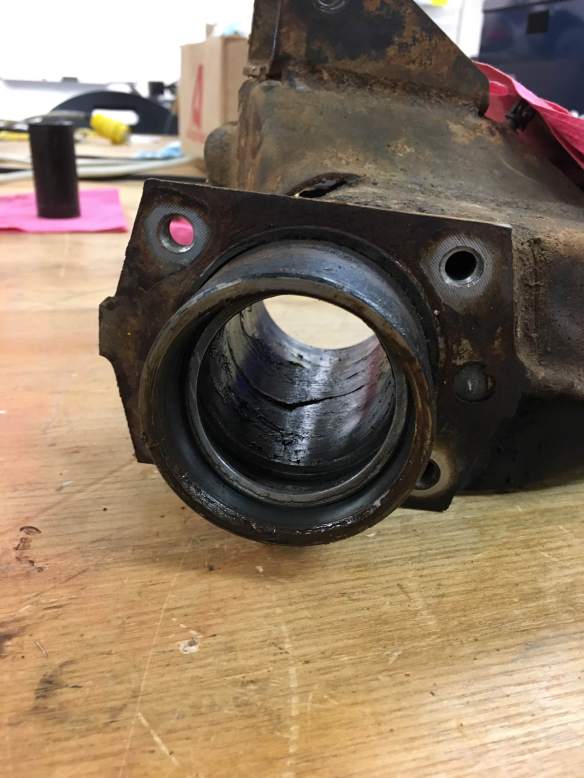

9a. I went ahead and replaced my trailing arm bushings while I had the arm out. I took a drill press and used a long circle-cutting bit to carefully cut the rubber around the old metal bushing centers. That weakened the bushing enough to where I was able to spin them and pull them out pretty easily. Then I took the new bushings, put a thin coat of petroleum jelly on them and drove them in with an arbor press. They went in easily and popped out the other side, seated correctly.
10. Next came the arbor press. I packed the new bearings by hand. I put a big glob of grease in my hand and squished the new bearing into it like dipping a chip into hummus until the grease squirted through the other side of the ball bearings. I did so all the way around the bearing and then I wiped the grease out of the middle of the bearing and then smoothed the grease around the bearing with my finger so that it looked like a nice, jelly-filled jewish wedding cookie. You want a nice, even layer of grease in between all the ball bearings–no air bubbles.
11. I inserted the inner bearing first. I had my friend hold the trailing arm in place on the press, put a circular bearing driver plate between the press and the bearing and carefully drove the bearing down until it made contact with the shoulder inside the trailing arm. You can feel if it’s in contact with the shoulder by sticking your finger in through the inner race of the bearing and feeling the inside of the bearing cavity. You’ll feel it when the bearing makes contact though because the arbor press will stop pressing.
12. Before I put the grease seal on, I packed a bit of extra grease into it. I figure it can only help and it won’t hurt anything. I carefully drove the new grease seal into place on top of it using the press and a suitably wide socket head. I had to be extra careful with the seal. It slipped in awkwardly at first and I had to take a hammer and gently tap it until it was straight and then drove it in the rest of the way until it made contact with the bearing.

13. I put the metal spacer sleeve into the space between the bearings. I just lined it up with the center as much as I could. You don’t have to be extra careful with it because there’s a slight space between it and the bearings so it moves around pretty freely inside the cavity. The thin layer of grease on its end edge is enough to pretty much hold it in place as long as you don’t yank the assembly around.
14. Next I did the same as in step 12 with the outside bearing, making sure to put in the metal spacer shim first, the bearing second. Do the same as the first. Press it in, supporting the outer race with a bearing press tool until it makes contact with the inside shoulder. I left the outside grease seal off until after I pressed-in the splined axle.
15. Driving in the splined axle is a bit more involved. The center bearing races will be supported by the metal spacer sleeve. The inner bearing’s outer race will be supported by the shoulder inside the trailing arm’s bearing cavity. The outer bearing’s outer race will need to be supported by a socket that is big enough and long enough to straddle the threaded end of the splined axle as it comes through the inner race while also supporting the outer race of the outer bearing so that driving the splined axle through doesn’t push the bearing away from its seat on the shoulder.
16. I put a thin layer of grease on the splined axle before I pressed it in. When properly supporting the bearings, the splined axle should press in relatively easy. Make sure the socket you use to support the outer bearing is long enough to let the splined axle come all the way through. You’ll feel when the splined axle makes contact with the inner bearing. It’ll stop pressing through. You’ll also be able to see that the dust cap is slightly concealed. It has a very finished look and you should be able to tell when you’ve driven it in properly. The threaded end of the splined axle should stick out of the center of the outer bearing by about three inches give or take an eighth of an inch or two.
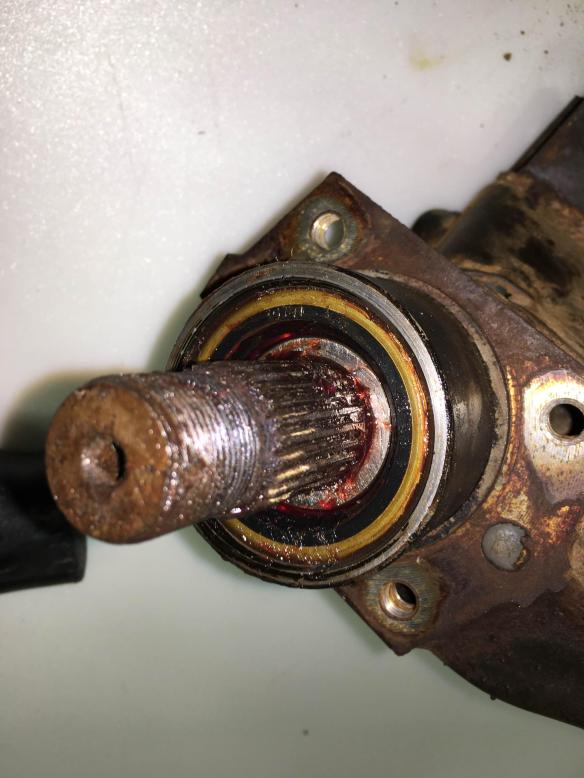
17. Next I used the same socket as in step 16 to drive the new grease seal into place. I also packed this grease seal with extra grease.
18. Reassembled unit.

19. Reassembly is the reverse of disassembly. I didn’t really torque anything to spec. I just tightened the three trailing arm bolts back into place as tight as I could. The big question for me was the castellated nut. I re-tightened it with the air impact wrench, then I put the hub and tire back on and I could wobble the tire laterally quite a bit, which was alarming. Then I took the tire and hub back off and, using a socket wrench, was able to tighten it a further 1/4 turn. Then I hit it again with the impact for good measure. When I reattached the hub and tire this time, the wheel was rock solid. No wobble at all. It drives great now but I’m paranoid about the driver’s side bearings now so I can’t enjoy it. I need to do that side too.
This was a very rewarding job and I want to do the other rear wheel now in the interest of uniformity.




